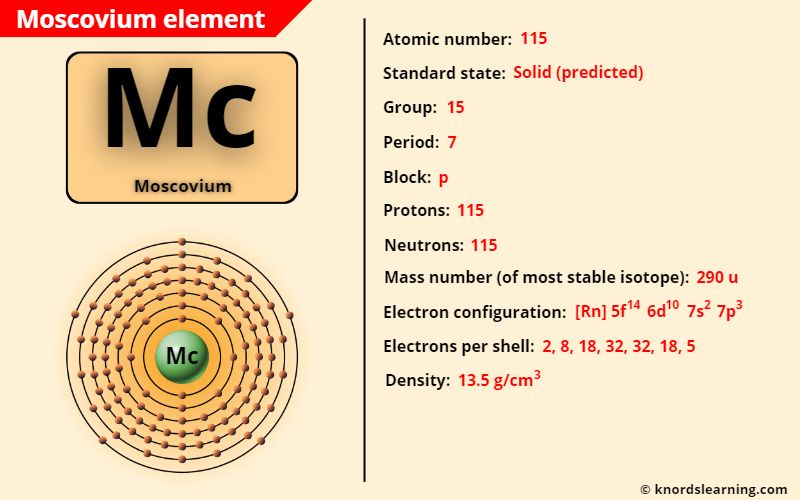
Moscovium element (Mc) is in group 15 and period 7 of a periodic table. Moscovium is in the p-block and it is classified as a radioactive synthetic element on the periodic table.
There is a lot more information related to moscovium which is mentioned in the Information Table given below.
So let’s dive right into it!
Table of contents
- Moscovium element (Information Table)
- Moscovium element in Periodic table
- Facts about Moscovium
- Properties of Moscovium
- Uses of Moscovium
Moscovium Element (Information Table)
The important data related to moscovium element is given in the table below.
| Atomic number of moscovium | 115 |
| Symbol of moscovium | Mc |
| Atomic mass of moscovium (most stable isotope) | 290 u |
| Protons in moscovium | 115 |
| Electrons in moscovium | 115 |
| State of moscovium (at STP) | Solid (predicted) |
| Group number of moscovium in periodic table | 15 |
| Period number of moscovium in periodic table | 7 |
| Block of moscovium in periodic table | p-block |
| Category of moscovium | Synthetic element |
| Bohr model or Electrons per shell or Electrons arrangement in moscovium | 2, 8, 18, 32, 32, 18, 5 |
| Electron configuration of moscovium | [Rn] 5f14 6d10 7s2 7p3 |
| Orbital diagram of moscovium |  |
| Density of moscovium (predicted) | 13.5 g/cm3 |
| Melting point of moscovium (predicted) | 400 °C |
| Boiling point of moscovium (predicted) | 1100 °C |
| Main isotope of moscovium | 290Mc |
Also see: Interactive Periodic Table (It has rotating bohr models as well as many other details of all the 118 elements in a single periodic table).
Moscovium element in Periodic table
The Moscovium element (Mc) has the atomic number 115 and is located in group 15 and period 7.
| H | He | ||||||||||||||||
| Li | Be | B | C | N | O | F | Ne | ||||||||||
| Na | Mg | Al | Si | P | S | Cl | Ar | ||||||||||
| K | Ca | Sc | Ti | V | Cr | Mn | Fe | Co | Ni | Cu | Zn | Ga | Ge | As | Se | Br | Kr |
| Rb | Sr | Y | Zr | Nb | Mo | Tc | Ru | Rh | Pd | Ag | Cd | In | Sn | Sb | Te | I | Xe |
| Cs | Ba | La* | Hf | Ta | W | Re | Os | Ir | Pt | Au | Hg | Tl | Pb | Bi | Po | At | Rn |
| Fr | Ra | Ac** | Rf | Db | Sg | Bh | Hs | Mt | Ds | Rg | Cn | Nh | Fl | Mc | Lv | Ts | Og |
| *Ce | Pr | Nd | Pm | Sm | Eu | Gd | Tb | Dy | Ho | Er | Tm | Yb | Lu | ||||
| **Th | Pa | U | Np | Pu | Am | Cm | Bk | Cf | Es | Fm | Md | No | Lr |
Click on above elements in the periodic table to see their information.
Facts about moscovium
Here are a few interesting facts about the moscovium element.
- Moscovium was given its name from the region “Moscow Oblast”, which is in Russia. Moscovium was discovered in the Joint Institute for Nuclear Research which is located in Moscow Oblast.
- Moscovium is not available naturally and it is made artificially in the lab.
- The isotopes of moscovium are radioactive in nature.
- 290Mc is the most stable isotope of moscovium which has a half life of only 0.6 seconds.
Properties of moscovium
Here is a list of some physical properties and chemical properties of moscovium.
- Moscovium is so radioactive that its half life is only 0.6 seconds.
- The moscovium is predicted to have solid state at standard temperature and pressure.
- The density of moscovium is predicted to be 13.5 g/cm3 and its most stable isotope has an atomic mass 290 amu.
- The most common predicted oxidation states of moscovium are +1 and +3.
Uses of moscovium
Moscovium has no commercial uses due to its scarcity and highly radioactive nature. It is generally used for research work.
External resources:
- Moscovium – Element information, properties and uses | Periodic Table. (n.d.). Moscovium – Element Information, Properties and Uses | Periodic Table. https://www.rsc.org/periodic-table/element/115/moscovium
- Moscovium – Wikipedia. (2013, October 4). Moscovium – Wikipedia. https://en.wikipedia.org/wiki/Moscovium
- P. (n.d.). Moscovium | Mc (Element) – PubChem. Moscovium | Mc (Element) – PubChem. https://pubchem.ncbi.nlm.nih.gov/element/Moscovium
- It’s Elemental – The Element Moscovium. (n.d.). It’s Elemental – the Element Moscovium. https://education.jlab.org/itselemental/ele115.html
- Periodic Table of Elements: Los Alamos National Laboratory. (n.d.). Periodic Table of Elements: Los Alamos National Laboratory. https://periodic.lanl.gov/115.shtml
- Oganessian, Y. (2018, December 14). The making of moscovium. Nature Chemistry, 11(1), 98–98. https://doi.org/10.1038/s41557-018-0185-6
- Haynes, W. M. (Ed.). (2014, June 4). CRC Handbook of Chemistry and Physics. https://doi.org/10.1201/b17118
- Electronic structure of the elements. (2000, March). The European Physical Journal C, 15(1–4), 78–79. https://doi.org/10.1007/bf02683401
- Bedford, et al. (1996, April 1). Recommended values of temperature on the International Temperature Scale of 1990 for a selected set of secondary reference points. Metrologia, 33(2), 133–154. https://doi.org/10.1088/0026-1394/33/2/3
Jay is an educator and has helped more than 100,000 students in their studies by providing simple and easy explanations on different science-related topics. With a desire to make learning accessible for everyone, he founded Knords Learning, an online learning platform that provides students with easily understandable explanations.
Read more about our Editorial process.

